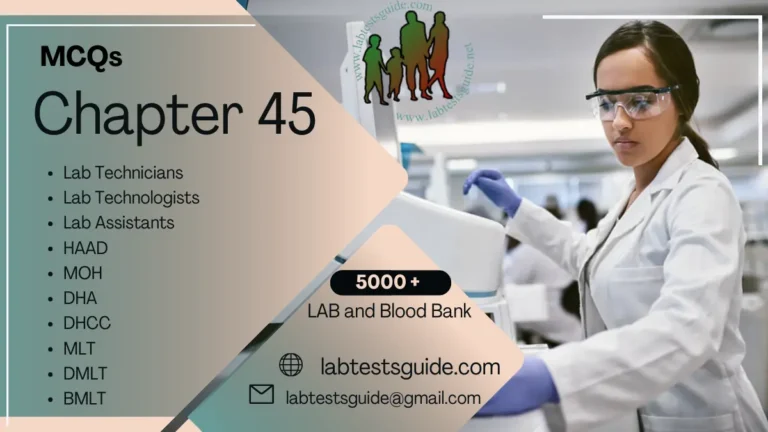Chapter 9: Nursing MCQs for Exams, Interviews and Entry Tests
5000 Plus Nursing MCQs for Exams, Entry Test and Job Interviews. MCQs are an important tool used in nursing education to test the knowledge and understanding of nursing students. These questions can cover a wide range of topics related to nursing practice, such as anatomy and physiology, pharmacology, nursing ethics, nursing theories, and more. MCQs are often used in nursing exams and assessments to evaluate students’ comprehension and ability to apply theoretical concepts to real-world scenarios.

401 to 450 MCQs for Nursing Exams, Interviews and Entry Tests
These questions can cover a wide range of topics related to nursing practice, such as anatomy and physiology, pharmacology, nursing ethics, nursing theories, and more.
401 to 450 MCQs
- The three layers of the uterus are:
- The peritoneum, the endocardium, the myocardium
- The myometrium, the endometrium, the perimetrium ✔
- The perineum, the endometrium, the myometrium
- The endometrium, the myocardium, the periosteum
- A fibroid tumour is also known as:
- Myalgia
- Myotic
- Myoma ✔
- Myeloma
- Dilation refers to:
- A reduction in pace
- Widening ✔
- Shrinking
- Death
- The cervix uteri is:
- A type of cancer
- A genital infection
- A term used to describe the lower part of the uterus ✔
- A term used to describe the upper aspect of the vagina
- A loop electrosurgical excision procedure is used to:
- Freeze the uterus
- Remove tissue from the vagina ✔
- Remove tissue from the uterus
- Remove tissue from the cervix
- Potential risks associated with cone biopsy include:
- Haemorrhage
- Cervical stenosis
- Inability of the cervix to stay closed during pregnancy
- All of the above ✔
- Cervical cancer:
- Is a common type of cancer
- Is an uncommon type of cancer ✔
- Is always associated with abnormal bleeding
- Only affects older women
- Oophorectomy is:
- A type of chemotherapy
- A form of radiation
- A surgical procedure to remove the vagina
- A surgical procedure to remove one or both ovaries ✔
- The Rule of Nines refers to:
- The depth of a burn
- Burn percentage in adults ✔
- Burn percentage in children
- Burn percentage in adults and children
- Radiation burns occur as a result of:
- High-voltage electricity
- Radiation and acids
- Sunburn, radiotherapy and radiation ✔
- Excessive exposure to heat
- Superficial burns affect:
- The underlying muscle
- The epidermis ✔
- The dermis
- All layers
- First aid for minor burns of the limbs includes:
- Elevating the limb
- Application of ice
- Applying pressure
- Reducing the heat by placing the affected limb under cold running water ✔
- Osseocutaneous skin flap is also called a:
- Mandible flap
- Tibial flap ✔
- Radial flat
- Facia flap
- The fundamental aim of plastic and reconstructive surgery is to:
- Regain movement
- Enhance self-esteem
- Provide restoration of function and aesthetic form ✔
- Prevent infection
- A skin flap may put a person at risk of:
- Infection ✔
- Malnutrition
- Pulmonary embolism
- Loss of mobility
- For any flap to survive, it must:
- Be from the same anatomical area
- Have a viable blood supply
- Have a viable nerve supply ✔
- All of the above
- The procedures, techniques and principles of cosmetic surgery concentrate on:
- Restoring function
- Restoring mobility
- Enhancing a person’s status
- Enhancing a person’s appearance ✔
- The key goals in cosmetic surgery are to:
- Improve aesthetic appeal
- Improve symmetry
- Improve proportion
- All of the above ✔
- Rhinoplasty refers to:
- Surgical procedure used to augment the breast
- A tummy tuck
- A refashioning of the nose ✔
- Injection of botox
- Botox is:
- An over-the-counter medication
- A banned substance
- A prescribed drug produced by the bacterium Clostridium botulinum ✔
- A prescribed drug produced by the bacterium Clostridium difficile
- Cataracts are:
- a. A painless condition ✔
- b. A painful condition
- c. Only present in people with diabetes
- d. Only present in the elderly
- The retina is:
- A sensory organ located above the eye
- A nerve layer located at the back of the eye ✔
- Only present in cataracts
- All of the above
- Phacoemulsification is:
- A complication of cataract surgery
- The most common cause of cataract
- The most common type of cataract surgery ✔
- An infection
- Mydriatics cause:
- ilation of the pupil ✔
- Constriction of the pupil
- Watering of the eye
- Anaesthesia
- A mastoidectomy is used to:
- Correct balance
- Remove diseased mastoid air cells ✔
- Remove the incus
- Prevent infection
- A mastoidectomy can treat complications of:
- Tinnitus
- Acute otitis media
- Chronic otitis media ✔
- All of the above
- A cochlear implant is:
- A device used to correct tinnitus
- A device used to correct imbalance
- Provided when the person has Ménière’s disease ✔
- Used to provide a sense of sound to person is profoundly deaf or severely hard of hearing
- Complications of mastoidectomy can include:
- Facial nerve paralysis and sensorineural hearing loss
- A change in taste
- Vertigo and tinnitus
- All of the above ✔
- When a nurse is tried under criminal law, the nurse is being brought to trial by:
- society as a whole. ✔
- the plaintiff’s lawyer.
- an organization.
- an individual.
- The newly licensed practical/vocational nurse begins work on a hospital unit where LPNs/LVNs are allowed to start intravenous fluids. The physician orders intravenous fluids to be started on one of this nurse’s assigned clients. Which of the following actions would be most necessary on the part of this newly hired and newly licensed nurse before starting an intravenous on the client?
- Check the hospital policy and check on any certification required. ✔
- Ask another nurse to do a supervised check on administering IVs.
- Ask one of your nursing-school instructors to refresh your skill
- Take a continuing-education IV course to make sure you have the skills.
- When working as a licensed vocational nurse, you determine that your client scheduled for surgery does not understand the physician’s earlier explanation of the surgery. The client is asking many questions about the risks and seems worried. Which of the following actions would be best on your part?
- Quickly explain the surgery procedures and the risks to the client.
- Cancel the surgery.
- Ask your supervising RN to explain the surgery procedure and its risks.
- Notify the physician. ✔
- You are the nurse working with an elderly, competent client who refuses a vitamin B injection ordered by the physician. The family insists that this injection be given, and you give it while the client is objecting. Even though the client improves, the client contacts a lawyer. From your knowledge of nursing and the law, you realize that you:
- did the right thing because the client improved.
- should have had the family put their request in writing.
- have commited an assault against the client.
- have committed an act of battery against the client. ✔
- When an LVN/LPN is working for a health-care organization that has professional liability insurance, the nurse needs to base a decision on whether to buy individual professional liability insurance on which of the following things?
- the possibility that the organization could countersue the nurse in a lawsuit ✔
- the cost of professional liability insurance to the nurse
- the amount and type of coverage the health-care organization carries
- the number of hours worked and the type of nursing work
- When documenting an assigned client’s record during and at the end of the shift, the nurse must keep in mind which of the following facts?
- In order to get the care done for all assigned clients, the charting must be as brief as possible.
- The proper format, such as SOAP or PIE, as chosen by the hospital, must be adhered to.
- The chart is a legal document and may be all a nurse has to support care that was given if called to court. ✔
- Clients need to be assessed and the care documented at least once every hour during the shift.
- When the licensed practical/vocational nurse is checking the physician’s orders against the medication record prior to setting up medications, the nurse discovers a medication error made on the previous shift. The nurse reports this error to the supervising nurse. Which of the following persons will need to fill out an incident report?
- licensed practical/vocational nurse who discovered the error ✔
- licensed nurse who committed the medication error the previous shift
- supervising nurse who is in charge of the nursing care unit
- primary nurse assigned to this client the previous day
- You are a student nurse working as a part-time or temporary nursing assistant in a nursing home. The nurse on duty asks you to insert a nasogastric tube in a patient. You have recently passed an examination on putting in a nasogastric tube. Which of the following actions is best on your part?
- Go ahead and insert the nasogastric tube.
- Ask the nurse to supervise you while you insert the tube.
- Call your school instructor for help with your decision.
- Tell the nurse that you cannot legally insert this tube. ✔
- According to the nursing code of ethics, when working as a nurse and a conflict comes up between your client’s needs and what the family and/or the physician wants, and/or the hospital policies, your first loyalty is to the:
- hospital.
- client. ✔
- family.
- physician.
- Which of the following strategies can most help you as a nurse to enhance your ethical practice and client advocacy?
- reading a book on religions of the world
- examining and clarifying your own values ✔
- talking with peers about their beliefs and values
- buying a nursing book on ethical decisions
- Which of the following actions by a practical/vocational nursing student represents the best example of deductive reasoning?
- observing that a client is constipated then doing some data gathering on client’s health practices
- assessing a client using Maslow’s Hierarchy, then defining client’s problem in terms of nutrition ✔
- suspecting that a client is not being truthful and checking other sources for information
- identifying several alternative courses of action and deciding on the best course of action
- In the daily practice of nursing, nurses use critical thinking in:
- setting priorities for the day. ✔
- every decision that is made.
- calling the pharmacy to obtain a medication.
- checking supplies in the client’s room.
- When the nurse problem solves and has implemented a solution from several solutions identified, the nurse most needs to do which of the following things?
- Discard the solutions that were not selected for implementation.
- Implement a second solution, comparing its usefulness with the first solution.
- Evaluate the effectiveness of the solution implemented. ✔
- Consider the problem solving completed in this case.
- Using Strader’s seven-step decision-making process, the nurse needs to first identify the purpose. What must the nurse do next?
- Decide who will be involved in the decision.
- Enlist the cooperation of the client.
- Set the criteria. ✔
- Identify solutions.
- Nurses, as they progress in their education, will most likely do which of the following things?
- Learn to develop a personal theory of nursing. ✔
- Become less interested in bedside nursing.
- Lose their ability to think critically in clinical areas.
- Have increased enjoyment when doing paperwork.
- When nurses assist clients in exploring their lifestyle habits and health behaviors to identify health risks, nurses are most likely to use which of the following models?
- medical model
- wellness models ✔
- psychosocial model
- physiological model
- The lowest level of needs in Maslow’s Hierarchy of Needs is which of the following?
- safety and security needs
- love and belonging needs
- physiologic needs ✔
- self-esteem needs
- In Hildegard Peplau’s Interpersonal Relations Model, the focus is on which of the following?
- individual ✔
- community
- larger society
- Family
- In Virginia Henderson’s 1966 definition of nursing, a person/client has which of the following numbers of fundamental needs ?
- 7
- 14 ✔
- 18
- 22
- Which of the following therorists stressed energy fields in their nursing theory?
- Dorothea Orem
- Helen Neuman
- Rosemarie Parse
- Martha Rogers ✔
- Which of the following reasons is the most important, as well as the most widely accepted, reason for nurses using nursing process?
- Increase the unique body of knowledge known as nursing.
- Help clients meet their actual and potential health problems.
- Communicate with other members of the team. ✔
- Standardize the care of clients with the same diagnoses.
- The primary source of data for the client’s database is which of the following sources?
- nurse’s recording of health history
- recent clinic or hospital records ✔
- physician’s history and physical
- Client
The importance of MCQs in nursing education cannot be overstated. Nursing is a demanding and complex field that requires a high level of knowledge and skill. Nurses are responsible for the care of patients, and they must be able to make informed decisions quickly and effectively. MCQs help to ensure that nursing students are adequately prepared for the challenges they will face in their careers by testing their knowledge of the key concepts and principles that underpin nursing practice.
One of the primary benefits of MCQs is that they provide a standardized way of assessing nursing students’ knowledge. Unlike open-ended questions or essay questions, which can be subjective and difficult to grade consistently, MCQs are designed to be objective and straightforward. Each question has a clear right or wrong answer, which makes it easier for instructors to evaluate students’ performance and compare their results to those of their peers.
Another advantage of MCQs is that they can be used to test a broad range of knowledge and skills. Nursing MCQs can cover a variety of topics, from basic anatomy and physiology to complex pharmacology and nursing interventions. This allows instructors to evaluate students’ understanding of the full spectrum of nursing practice and identify areas where they may need additional support or instruction.
MCQs can also be used to assess different levels of learning. For example, some questions may test students’ recall of basic facts and concepts, while others may require them to apply their knowledge to solve a problem or make a clinical judgment. By using a mix of different types of questions, instructors can get a more comprehensive picture of each student’s strengths and weaknesses and tailor their instruction accordingly.
There are some potential drawbacks to using MCQs in nursing education, however. One concern is that MCQs may not accurately reflect the complexity of nursing practice. Nursing is a field that requires a high degree of critical thinking, problem-solving, and clinical judgment, and MCQs may not fully capture these skills. Additionally, some nursing students may struggle with multiple-choice questions, particularly if they have learning disabilities or other challenges that affect their ability to process information quickly.
Despite these concerns, however, MCQs remain an important tool in nursing education. They provide a standardized and objective way of assessing nursing students’ knowledge, and they can cover a broad range of topics and levels of learning. With careful design and implementation, MCQs can be an effective way to evaluate nursing students’ performance and ensure that they are adequately prepared for the challenges they will face in their careers.
Possible References Used









